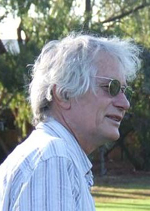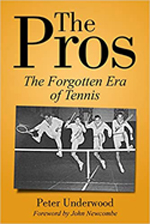Tilden and Others on Tour
Peter Underwood

On February 18, 1931, Bill Tilden made his professional debut at Madison Square Garden. It was the opener of a head to head series to establish the World Pro Champion. His opponent was Karel Kozeluh. A response of "Karel who?" is understandable. Who was he? And where was pro tennis when Tilden strode onto the huge Garden stage to play him?
Professional competitive tennis, as distinct from teaching tennis as a paid job, began in Western and Central Europe just after the turn of the twentieth century. By the end of the first decade, pro championships were fixtures in several European countries, and the top players, usually teaching pros attached to private clubs, would travel to compete at them.
By the mid-twenties, the Czech Kozeluh had become recognized as the top player in this unassuming circuit, a poor relation of the glorious amateur championships of the major western countries inside and outside Europe.
Cash and Carry
Then came a dramatic development, and an upping of the stakes. Typically, it came from the land of entrepreneurs across the Atlantic. Charles C. Pyle was an American millionaire whose fortune was based on a retail chain.
He preferred to be called Cash and Carry Pyle after the name of his empire. Now this pragmatic merchant just couldn't see why one tennis player shouldn't play any other. Didn't they live in God's freest country?
So if the public wanted to see any of them play their game, and were ready to pay for the privilege, why shouldn't they play, and take their cut? Pyle first organized a series of matches between former amateurs, in which they received payment from the gate.
Then he began to conceive of a pro tour, including men and women. Businessman Pyle calculated his innovation could yield a decent profit--both for the players and for him.
In 1926, Cash and Carry put together the first-ever pro tour. Pyle went straight to the top, and immediately snared the world's best female player--and tennis' darling--Suzanne Lenglen. Then he went for Tilden.

But at that time Big Bill was dreaming of Hollywood and refused. Little Bill Johnston was a patriot tied to playing for his country and refused in order to keep his amateur status for Davis Cup.
Vincent Richards
But Pyle found someone close to the top of the amateur tree, Vincent Richards, a onetime tennis prodigy and Tilden protege. It was true that Richards had never won a major. But he'd come close and was a magnificent Davis Cupper. Tennis was then an Olympic sport, and Richards was the reigning Olympic Champion, having defeated Henri Cochet in the final.
With a game based on brilliant net play, Richards was ebullient in character and style. Crowds loved him. He had also won the U.S. Doubles with Tilden, when Richards was only 15 years old.
Not long after delivering Richards to the pro troupe, with some difficulty Cash and Carry proceeded to fill up the field. Beginning in late 1926, a tour through the States followed. Although it went well at first, the cash flow stuttered. There was one major reason: Richards and Lenglen were a class above the rest of the troupe. Yet the tour survived.
Then Richards won the first US Pro Championship in 1927. He then went to Europe, and took in the pro scene there. Richards was impressed, especially with his opposite number on the Continent, Karel Kozeluh. After much bargaining, Richards signed the Czech, and in late 1928 they began the first ever head-to-head tour. It began in Europe, and ended with a sweep of the US.

The European champion and defensive master Kozeluh was fairly evenly matched against attacker Richard and it was hard to say who was the World Pro Champion in the two years that followed.
Kozeluh Wins
Kozeluh won the tour against Richards, but then lost to him in the second US Pro Championship in 1928, yet beat him for the third in 1929. Richards then Kozeluh in the fourth US Pro Championships in 1930 but suddenly announced his retirement.
Kozeluh was now indisputably the top pro player, so it was he who faced Tilden on a winter's evening in New York in 1931 after Tilden had decided to play professionally.
Kozeluh--nicknamed "Professor" due to his studious and lugubrious manner--began as a master of defense on the clay court. But on the faster courts outside Europe, he was soon showing that he could compete against any of the top players of the day, pro or amateur on any surface.
Nevertheless, in their first clash of February 1931 in the Garden, Tilden managed a fairly comfortable win. To many astute observers, Tilden--despite his age or because of it--had finally learned the key to handling a master defender such as Kozeluh. Attack.
In the following long tour to settle the title, most of which was played on fast indoor courts, Tilden beat the Czech decisively, 63 matches to 13. After that, with some ups and downs, Tilden held the position of top pro for the next three years. Before long he'd also taken over the management of the tour.

Big Bill built on the steps of the European pros and of Pyle and Richards. Pro tennis was internationalized, with tours and tournaments run in the Far East and South America as well as in the US and Europe. Further, the national pro championships--the US, French and British--became annual fixtures, and attempts were also made to develop national pro teams competing along Davis Cup lines.
Tilden was indefatigable. In his first seven years as a pro, Tilden played over 1500 matches, or two competitive matches every three days. In those seven years, he missed only three matches from injury.
Despite such energy, the whole set-up never got past being another tiny, down-at-heel heel travelling circus. Sometimes the pro band had a good run, but often they were scratching out a living from any place that made an offer. And always they were outcasts.
According to Vincent Richards, "There was a stigma to playing for filthy lucre. As an amateur, you were showered with hospitality but as a pro, you were ignored." Forty years later, Rod Laver was saying the same thing.

However, if Tilden's drive had launched and then sustained the new pro era, beneath the surface the old trooper was in trouble. By the time he had joined the pros--and soon had turned forty--Big Bill was becoming increasingly singular, rootless and febrile. Although a terrible businessman, in his first decade as a pro he'd made a lot of money. But he spent it as fast as he earned it.
Whether it was in New York or in Independence, Kansas, he stayed in the best suite of the best hotel. With his family inheritance long gone, as the years rolled on the man was adding poverty to that cruel duo of aging and loneliness.
Contributing to his financial stress were his theatrical ambitions. From early adulthood he tried repeatedly and desperately to make a career in the theatre--and lost a fortune. In fact, he always claimed that tennis ranked third for him: music and the stage were his greatest loves and preferred careers.
But he had no musical ability, and little as a stage actor. Even in the role of Dracula--which he played for a short season on Broadway--his flaw of overacting was fatal.
He also tried hard at writing fiction, but the only eminence he achieved in the literary arena was as a character in another writer's novel. In Nabokov's Lolita, Lolita takes tennis lessons from a former great player who has a harem of ball boys. The wrinkled old coach's name is Ned Litam. Backwards, Ned Litam spells Ma Tilden.





